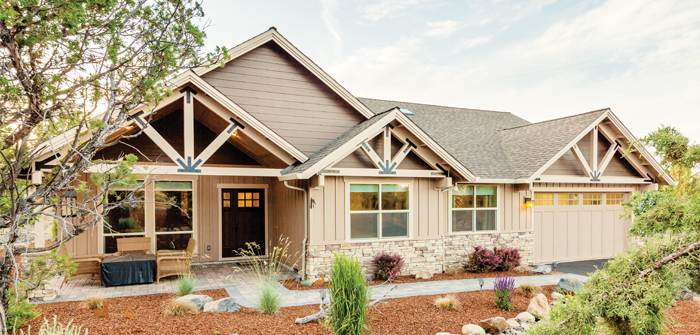(Photo above: New Era Home | Photo by Cheryl McIntosh Photography)
Financing Your Land & Home A Bare Land Loan or a Home & Land Package?
Whether you are just starting the homebuilding process and shopping for land, or you have land and are ready to take the next step, understanding the financing process can help save time, money and frustration. We have compiled a few tips to help you prepare for the financial aspect of building a home on your own land. We met with mortgage loan officer, Jackie Westover at Umpqua Bank, to provide insight on bank requirements that impact loan timing and eligibility.
Financing Options
There are two ways to buy land using bank financing: a bare land loan and a home & land package.
There are few lenders willing to lend on bare land so this is the most difficult type of loan to secure. With a land loan, a lender will require a significant down payment, limit the loan period and charge a higher interest rate to compensate for the perceived risk of lending on bare land.
The most common misconception is that buyers must have the land secured before they can begin the building process. That is not the case with the second type of land financing referred to as a land and home loan package. This loan provides funding to buy the property and immediately begin construction of a new home. The interest rate on this loan is lower, the loan period is usually 12 months or less, the down payment requirements are less and there is only one set of loan fees.
The land & home loan has a shorter duration so having a qualified builder in place allows the buyer to get a head start on the budgeting and planning process. This allows construction to begin immediately upon the land purchase and loan closing.
The loan process is generally straightforward and less time consuming if the customer already owns their own land. Also, owning land for a year prior to building means the property is “seasoned.” This allows the bank to use any equity in the property to offset the down payment requirements of the loan.
It is wise to engage the builder prior to placing a land offer for several reasons. The builder will determine if the property has major services available (water, power, sewer), whether zoning will allow for the intended use and whether there are deed restrictions that will impact construction. The builder will determine if the land development costs will fit the overall budget and if the property will accommodate the desired floorplan.
Part of the lending process is obtaining an appraisal to justify the value of the land or land/home package. For a land and home loan, the appraisal is based on the contract, description of materials, plans, specs and the overall budget including land and development costs. With rising prices in an escalating market, the appraised value may come in less than the land and building costs. A low appraisal means the borrower will need to increase the down payment on the purchase. The best case scenario is that the appraised value comes in, at, or above the cost of acquisition/construction.
Timing
There are variables that effect the length of time it takes to close on a construction loan but 45-90 days is typical with 60 days being the average. Negotiating a realistic closing date allows the lender, builder and borrower enough time to perform their duties and ensure a smooth closing of the land.
Due to tightening lending standards, it is important for the borrower to understand that the amount of documentation to secure a loan is immense. Providing information to the bank in a timely fashion streamlines the process considerably.
Budgeting
No matter how budget conscious the planning process is, sometimes things still come up during construction that impact costs. Banks build in a contingency for unforeseen issues; in Central Oregon, we call it the rock clause. While it’s generally used for unexpected permitting or land development costs, borrowers can also access it for upgrades.
During the course of construction, upgrades outside of the contract are paid for out of pocket by the homeowner. After the project is completed, homeowners can be reimbursed out of the contingency fund if it hasn’t been used for essential construction and development items. It is important to have the conversation with your builder up front to know how mid-construction changes will affect the process and budget.
5 Tips to Streamline
Land & Home Financing
Today’s underwriting process looks much different than it did ten years ago. Everyone, regardless of income level and credit score, goes through the same process. However, there are steps you can take as the buyer to help streamline the process.
Seek loan preapproval early on. This allows credit, income and assets to be reviewed ahead of time to ensure there are no surprises.
Hold onto cash! Cash is often more important during the process than paying off debt.
Stay consistent. Keep your job, don’t apply for any new credit or move investment or cash locations. Significant changes can cause a borrower to be denied loan approval.
Know what you’re comfortable with for the monthly mortgage payment. Often what you can be approved for and what you’re actually comfortable with are entirely different numbers!
Know about water, waste removal and permit availability. This is where engaging a qualified builder early on can be especially helpful.
“I like working with New Era Homes because they build a good, solid home AND understand the paperwork part. We value working with builders who understand the business piece of the process so we made New Era Homes a preferred builder. We appreciate New Era Homes quality, experience and how they pay their bills,” adds Jackie Westover, mortgage loan officer, Umpqua Bank.
For information about building a New Era Home on your own land, contact Sales Manager, Trent Gardner at 541-330-5463 or visit www.newerahomes.com





